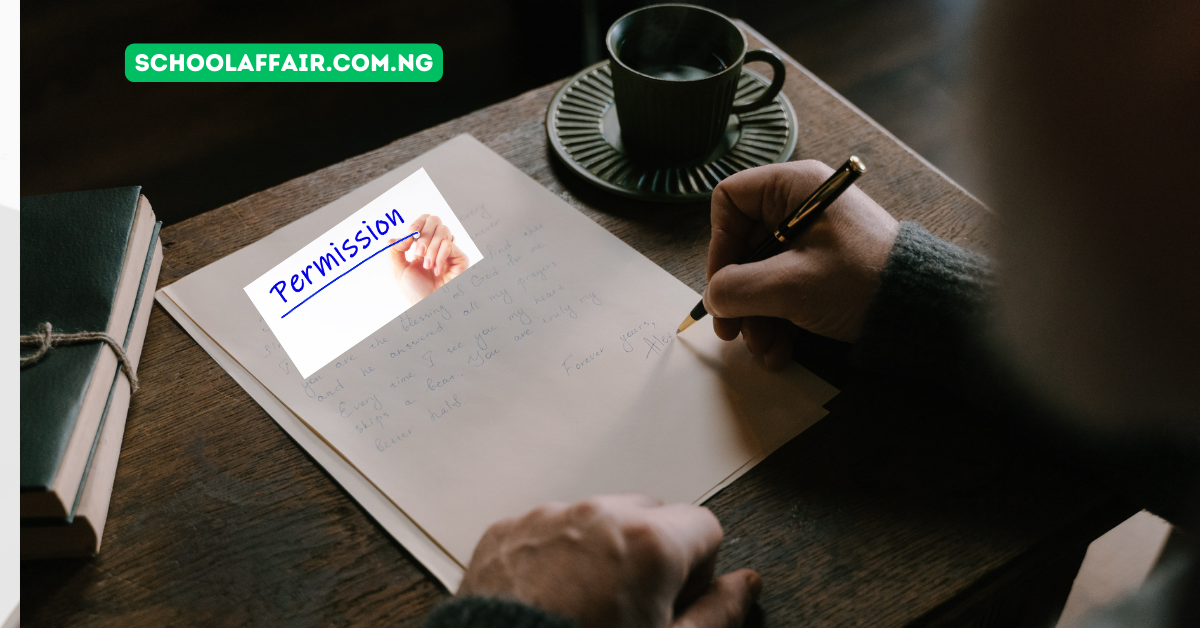A permission letter is a formal document granting authorization to someone or a party to perform a specific action, access a particular place, or use certain resources. It is a written consent that clarifies the terms and conditions under which the permission is granted.
- Importance and Purpose of Writing a Letter of Permission
- Types of Situations Where a Letter of Permission May be Needed
- Understanding the Format and Structure of a Permission Letter
- Preparing to Write the Letter: Things to Consider and Gather
- Step-by-Step Guide to Writing a Letter of Permission
- Tips for Writing a Clear and Concise Permission Letter
- Dos and Don'ts of Writing a Permission Letter
- Common Mistakes to Avoid While Writing a Letter of Permission
- Examples of Well-Written Permission Letters for Various Scenarios
- Perfect Example Excuse Letter for Permission
- Importance of Proper Language and Tone in a Permission Letter
- Addressing the Recipient and Salutation in a Permission Letter
- Body of the Letter: What to Include and How to Organize Information
- Providing Necessary Details and Supporting Documents in the Letter
- Requesting for a Response or Action in the Letter
- Proper Closing and Signature in a Permission Letter
- Understanding the Legal Implications of a Permission Letter
- Special Considerations for Writing a Permission Letter for Minors or Students
- Following Up on the Letter and Dealing with Potential Denials or Delays
- Conclusion: Summarizing the Key Points and Emphasizing the Importance of a Well-Written Permission Letter
Importance and Purpose of Writing a Letter of Permission
The primary purpose of a permission letter is to ensure clarity and transparency in transactions, activities, or situations where authorization is required. It serves to protect the rights and interests of both parties involved and helps avoid misunderstandings or legal complications.
Types of Situations Where a Letter of Permission May be Needed
Permission letters are commonly required in various situations, including but not limited to:
- Travel: When a minor is traveling alone or with someone other than their legal guardian.
- Events or Activities: Participating in events, contests, or activities that require explicit consent.
- Property Access: Granting permission to access a property or specific area.
- Research or Data Use: Allowing the use of data, images, or research findings for specific purposes.
- Medical Treatments: Authorizing medical treatments for minors or dependents.
Understanding the Format and Structure of a Permission Letter
A standard permission letter generally includes:
- Sender’s Information: Name, address, and contact details of the person granting permission.
- Recipient’s Information: Name, address, and contact details of the person or entity receiving permission.
- Date: The date on which the letter is written.
- Subject: A brief description of the purpose of the letter.
- Salutation: Greeting to the recipient.
- Body: clearly stating the permission granted and any relevant conditions.
- Closing: A formal closing statement.
- Signature: The sender’s signature.
Preparing to Write the Letter: Things to Consider and Gather
Before writing a permission letter, consider the following:
- Clarity of Purpose: Clearly understand why permission is being granted.
- Details of Permission: Specify the scope and limitations of the permission.
- Recipient Information: Ensure accurate details of the person or entity receiving permission.
- Legal Requirements: Be aware of any legal or regulatory requirements related to the permission.
Step-by-Step Guide to Writing a Letter of Permission
- Start with a clear purpose. Clearly state the purpose of the permission.
- Provide specific details. Clearly outline what is being permitted and any conditions.
- Be Concise and Clear: Use clear language and avoid unnecessary details.
- Include Relevant Dates: Specify the duration or timeline of the permission.
- Express Gratitude: Thank the recipient for their cooperation and adherence to the terms.
- Offer contact information: Provide contact details for further clarification if needed.
- Request Acknowledgment: Ask the recipient to confirm their understanding and agreement.
Tips for Writing a Clear and Concise Permission Letter
- Use Simple Language: Avoid jargon and complex language.
- Be Specific: Clearly define the scope of the permission.
- Proofread: Ensure there are no errors or ambiguities.
- Maintain a Professional Tone: Keep the tone formal and respectful.
- Provide supporting documents: Attach any necessary documents to support the permission.
Dos and Don’ts of Writing a Permission Letter
Dos:
- Clearly state the purpose.
- Include all relevant details.
- Use a formal and respectful tone.
- Proofread for clarity and accuracy.
- Attach any necessary supporting documents.
Don’ts:
- Use ambiguous language.
- Include unnecessary details.
- Use informal language.
- Neglect to proofread for errors.
- Assume the recipient’s understanding without clarification.
Common Mistakes to Avoid While Writing a Letter of Permission
- Ambiguity: failing to clearly define the terms of permission.
- Oversights: forgetting important details or conditions.
- Informality: using an inappropriate or overly casual tone.
- Assumptions: Assuming the recipient’s understanding without seeking clarification.
- Lack of clarity: not clearly expressing the purpose and scope of the permission.
Examples of Well-Written Permission Letters for Various Scenarios
- Sample Letter Granting Permission for Travel
- Permission Letter for Event Participation
- Authorization for Property Access
- Letter Allowing Data Use for Research
Perfect Example Excuse Letter for Permission
[Your Name]
[Your Address]
[City, State, ZIP Code]
[Email Address]
[Phone Number]
[Date]
[Recipient’s Name]
[Recipient’s Position or Title]
[Organization or Institution Name]
[Address]
[City, State, ZIP Code]
Subject: Request for Permission [Brief Description]
Dear [Recipient’s Name],
I hope this letter finds you well. I am writing to request your permission for [briefly describe the purpose or activity for which permission is sought], scheduled to take place on [date and time]. Unfortunately, due to unforeseen circumstances, I am unable to [attend, participate, or complete the task] on the initially agreed-upon date of [original date].
I understand the importance of adhering to schedules and timelines, and I sincerely apologize for any inconvenience my request may cause. I have taken every possible measure to minimize disruption and ensure that the rescheduled activity or task will be executed efficiently.
I kindly seek your understanding and support in granting permission for the revised date of [new date and time]. The delay is due to [provide a brief explanation of the circumstances causing the delay], and I assure you that I am committed to ensuring the successful completion of [the activity or task].
Enclosed with this letter, you will find [any supporting documents, if applicable] that may provide further insight into the situation. If you require any additional information or clarification, please do not hesitate to contact me at [your phone number] or [your email address].
I value your understanding and cooperation in this matter. Thank you for considering my request. I am confident that, with your permission, I can successfully proceed with [the activity or task] on the rescheduled date.
Sincerely,
[Your Full Name]
[Your signature, if sending a physical letter]
Importance of Proper Language and Tone in a Permission Letter
Proper language and tone convey professionalism and ensure that the letter is taken seriously. Clear communication is essential to avoid misinterpretation of the granted permission.
Addressing the Recipient and Salutation in a Permission Letter
Address the recipient formally, using their proper title and name. The salutation should be respectful, such as “Dear [Title] [Last Name].”
Body of the Letter: What to Include and How to Organize Information
Organize the body of the letter logically, starting with the purpose, followed by specific details of the permission, any conditions, and relevant dates. Use paragraphs for clarity.
Providing Necessary Details and Supporting Documents in the Letter
Include all pertinent details, such as names, dates, locations, and any relevant conditions. Attach supporting documents, such as IDs or event details, when necessary.
Requesting for a Response or Action in the Letter
Conclude the letter by requesting the recipient to acknowledge their understanding and agreement to the terms. Please provide contact information for any questions or clarifications.
Proper Closing and Signature in a Permission Letter
Close the letter with a formal statement, such as “Sincerely” or “Best Regards.” Sign the letter with a handwritten signature if sending a physical copy, or include a scanned signature in electronic copies.
Understanding the Legal Implications of a Permission Letter
A permission letter may have legal implications, depending on the context. It is advisable to consult legal advice when dealing with sensitive matters to ensure compliance with relevant laws and regulations.
Special Considerations for Writing a Permission Letter for Minors or Students
When writing a permission letter for minors or students, ensure that the legal guardians are clearly identified and the scope of permission is well defined. Include emergency contact information and any specific requirements for the minor’s well-being.
Following Up on the Letter and Dealing with Potential Denials or Delays
Follow up on the letter to ensure the recipient has received and understood it. If there are denials or delays, seek clarification and address any concerns to find a resolution.
Conclusion: Summarizing the Key Points and Emphasizing the Importance of a Well-Written Permission Letter
In conclusion, a well-written permission letter is crucial for ensuring clarity, avoiding misunderstandings, and protecting the interests of both parties involved. By following the guidelines and tips provided, you can create a clear, concise, and effective permission letter for various situations. Remember, proper communication is the key to successful authorization.



